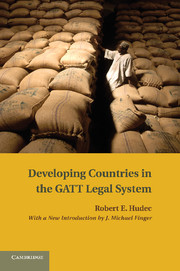Book contents
- Frontmatter
- Contents
- Foreword by Hugh Corbet
- Acknowledgments
- DEVELOPING COUNTRIES IN THE GATT LEGAL SYSTEM
- Introduction to the New Edition
- PART I A HISTORY OF THE LEGAL RELATIONSHIP
- 1 Post-war Negotiations on Trade Liberalization
- 2 First Decade of the GATT – 1948–1957
- 3 Demands for a New Legal Relationship – 1958–1963
- 4 Defining the New Relationship – 1964–1971
- 5 Testing the New Relationship – 1972–1979
- 6 Developments in the 1980s – Form without Substance
- PART II A LEGAL CRITIQUE OF THE GATT'S CURRENT POLICY
- List of References
- Index
5 - Testing the New Relationship – 1972–1979
Published online by Cambridge University Press: 03 May 2011
- Frontmatter
- Contents
- Foreword by Hugh Corbet
- Acknowledgments
- DEVELOPING COUNTRIES IN THE GATT LEGAL SYSTEM
- Introduction to the New Edition
- PART I A HISTORY OF THE LEGAL RELATIONSHIP
- 1 Post-war Negotiations on Trade Liberalization
- 2 First Decade of the GATT – 1948–1957
- 3 Demands for a New Legal Relationship – 1958–1963
- 4 Defining the New Relationship – 1964–1971
- 5 Testing the New Relationship – 1972–1979
- 6 Developments in the 1980s – Form without Substance
- PART II A LEGAL CRITIQUE OF THE GATT'S CURRENT POLICY
- List of References
- Index
Summary
IN THE EARLY 1970s, GATT governments began to plan the Tokyo Round of multilateral trade negotiations, known formally as the Multilateral Trade Negotiations, or MTN. Discussions began in 1972, and GATT trade ministers formally convened the negotiations and established the negotiating rules in Tokyo in September 1973. The negotiations started very slowly and did not end until the summer of 1979. Implementation of the Tokyo Round agreements took several more years.
LEGAL POLICY OF THE UNITED STATES
The decade in which the Tokyo Round negotiations took place witnessed a sharp turn – or at least an attempted sharp turn – in GATT legal policy. A serious effort was made to revive legal discipline among developed countries. In the very simplest terms, the effort can be seen as a change in the United States' policy towards GATT law. In the 1960s that policy had been dominated by two factors:
(a) The United States had a strong and growing economy.
(b) The political interests of the United States called for effective European integration and the growth of a strong and stable Japan.
During the 1960s both the European Community and Japan had employed a number of market-distorting measures in pursuit of their own economic and political development. It is not clear that such measures were actually beneficial, but the governments seemed to think they were and so the United States had tolerated them.
- Type
- Chapter
- Information
- Developing Countries in the GATT Legal System , pp. 75 - 98Publisher: Cambridge University PressPrint publication year: 2010



